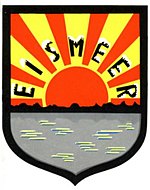Jagdgeschwader 5
| Jagdgeschwader 5 | |
|---|---|
 |
|
| Active | 1942–45 |
| Country |
|
| Branch | Luftwaffe |
| Type | Fighter Aircraft |
| Role | Air superiority |
| Size | Air Force Wing |
| Nickname(s) | Eismeer |
| Commanders | |
| Notable commanders |
Heinrich Ehrler (May 1944 - February 1945) |
Jagdgeschwader 5 (JG 5) was a Luftwaffe fighter wing during World War II. It was created to operate in the far North of Europe, namely Norway, Scandinavia and northern parts of Finland, all nearest the Arctic Ocean, with Luftflotte 5, created specifically to be based in Occupied Norway, and responsible for much of northern Norway.
JG 5 was formed when elements of the I. Gruppe/JG 77 already stationed in Norway was redesignated as I./JG 5 in January 1942. The II. Gruppe was newly created and III. Gruppe was formed from elements of I./JG 1 in May. The unit had the responsibility for providing fighter-cover over occupied territories under Luftflotte 5, and also to provide fighter support for the Heer (Army) units fighting on the Arctic front in the Murmansk area. JG 5 also had the important task of disrupting traffic on the Murmansk rail line, as this was the main artery of the Karelian Front defenders.
I. Gruppe was based on the west coast of Norway, in Stavanger, to defend against Allied anti-shipping attacks. II. and III. Gruppe was stationed at Petsamo in Finland, to support operations in the East. JG 5 had to cope with challenges that were unique within the Luftwaffe, from 24-hour days during summer when the sun never set, to the complete darkness and extreme cold of the polar winter.
By the beginning of polar summer of 1942, Luftflotte 5 had been reinforced and by July 1942 possessed a total of 250 serviceable aircraft. Operationally, these were controlled by Fliegerfuhrer Nord-Ost Obstlt. Walter Lehweß-Litzmann, responsible for operations over the front-line and by Fliegerführer Lofoten, Oberst. Ernst-August Roth, responsible for anti-shipping operations. Due to the air superiority established by II. and III./JG 5 early in the year, Luftflotte 5 enjoyed a numerical and considerable qualitative superiority, and the Soviet opposition amounted to just 170 serviceable combat aircraft. Fliegerführer Nord-Ost also benefited from a Freya early-warning radar network.
...
Wikipedia
